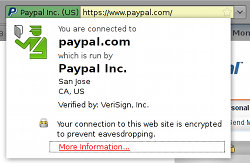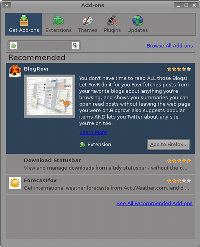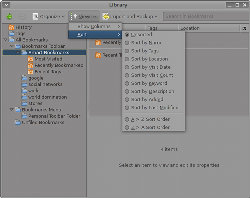Author: Nathan Willis
Firefox 3 is in testing, with the latest build, beta 4, released Monday. Mozilla is aiming for a final release of its flagship product before the end of the first quarter of 2008. Let’s take a look at the changes coming down the pike.
You can grab a copy of the latest Firefox 3 beta from mozilla.com. Linux, Windows, and Mac OS X Universal Binaries are provided in more than 40 languages. The Linux version is a bzip2-compressed tar archive. You can unpack into any location on your system.
Before running the beta, you must close all running instances of earlier versions Firefox. You should read the release notes before running the program, as there are some known issues. Since this is prerelease software, it is also a good idea to make a backup copy of your Firefox profile by executing cp ~/.mozilla ~/.mozilla-backup. Doing so will preserve all of your bookmarks, passwords, and other personal settings, as well as any extensions and plugins installed locally.
When you launch the Firefox 3 beta with ./firefox, it will automatically check extensions and plugins for compatibility, and disable any that are incompatible with Firefox 3. Don’t let Firefox 3 upgrade your incompatible extensions if you are planning on going back to Firefox 2 when you are done testing.
Security you can see
Security-related improvements feature prominently in Firefox 3. There are under-the-hood fixes, such as the disabling of extension updating over unencrypted connections, but many focus on better informing users of potential trouble.
For example, when visiting an HTTPS site in Firefox 2, the location bar changes color to indicate whether the connection is strongly or weakly encrypted. Firefox 3 takes this idea further, relocating certificate signature status from the bottom corner of the window up to the location bar itself. A verified site’s favicon is highlighted in green, while next to it the site’s certificate owner is displayed (making discrepancies between the site’s certificate and URL prominent), and detailed certificate info is accessible in a drop-down menu.
Considerable work has gone into making that detailed certificate information more human-readable. It reports certificate verification with Larry, a “passport official” symbol common to international airports, visually distinguishing between the identity verification offered by certificates and encryption status signified by the padlock symbol. The wording is also a vast improvement over the confusing pop-up warnings of older releases.
At least two other pop-up warnings are also put out to pasture in Firefox 3: SSL error alerts and the “save password” prompt. SSL errors are displayed with an error page (as is done with 404 errors), and the save password prompt appears in an information bar that drops down from the top of the page (much like the pop-up blocker information bar in Firefox 2).
The new browser also takes advantage of outside services to bolster security. It triggers available antivirus software when downloading an executable file, and issues warnings when the user visits URLs known to be phishing or malware sites — functionality provided by Google’s malware site flagging. On Windows systems, Firefox respects the OS’s “parental controls” settings, with which (for example) users can disable downloading of executables.
A streamlined interface
Changes to the GUI in Firefox 3 are the first things that will attract your attention. The basic browser window sports changes to navigation tools, while the download manager and add-ons manager are beefed up, and all of the interface elements better integrate into their OS-specific environments.
For basic navigation, the largely redundant Go button is gone, although a context-appropriate Go button appears in the location bar when you type a URL. The Forward and Back buttons and their respective drop-down histories are combined into a single unit colloquially referred to as the “keyhole.” It uses a single drop-down history list, in which the current URL is highlighted to show your position.
The location bar itself is getting a big enough facelift that Mozilla coders refer to it as the Awesomebar. For starters, both it and the search bar are resizeable — just grab and slide. More importantly, the URL autocompletion feature has been given a boost. When you start typing in the location bar, suggestions appear below — but now, they match previously visited URLs, page titles, and bookmarks, and find matches anywhere in the relevant text, not just at the beginning. The suggestions displayed show both page title and URL, and highlight the matching portion, making the different types of matches visually distinct.
The new Add-ons Manager allows users to manage plugins in addition to extensions, themes, languages, and search engines, making it the single source for all Firefox add-ons. You can also install add-ons provided through Mozilla’s official site within the Add-ons Manager itself, which is a convenience compared to the current behavior, which requires you to open the site in a browser window. It will also be easier to install third-party add-ons thanks to the removal of the old whitelist of approved sources.
The minimalist Downloads dialog of Firefox 2 has evolved into a Downloads Manager, complete with the ability to track all downloads’ progress in the status bar, the ability to pause and resume downloads across sessions, and the ability to search downloaded files.
It is also easier to specify the “download actions” preference for different file types (i.e., whether to open a particular file type within Firefox, or to choose a specific external application). These preferences include support for podcasts and video podcasts for the first time, and you can specify Web apps as the default launcher for a file type, just as you can specify desktop applications.
Last, but sure to be appreciated, Firefox 3 includes substantial improvements in OS integration. On Linux, the big story is the use of native GTK+ widgets for all buttons, menus, tabs, and form elements, making Firefox look like a native app without resorting to special theming. The Print and File open and save dialogs are native, too, replacing custom dialogs. Windows and Mac users get OS integration improvements, too, although the changes are fewer for those platforms.
New features
In addition to the interface refinements, a few entirely new features debut in Firefox 3.
While prior iterations of the browser allowed users to increase and decrease the font size in a Web page, that feature has been replaced with a more powerful full page zoom, which scales the entire rendered page — including graphics and layout — resulting in an easier-to-read enlargement without the disrupted readability of zooming the text alone.
A small but highly useful new feature is multiple text selection. When copying text to the clipboard, you can select multiple, disconnected regions by holding down the Control key.
Firefox gains several new ways to interact with bookmarks in the new release. As in Firefox 2, you can bookmark a page by dragging it to the bookmark toolbar or with the appropriate key combination, but you also add a bookmark by clicking on the new star icon in the location bar. Firefox 3 bookmarks also support tags. Tagging is optional, so you can continue to use bookmarks in the traditional manner, but you can search on your bookmarks’ tags, and tag matches will appear in Awesomebar’s suggestions. Finally, “recently bookmarked” and “recent tags” smart folders automatically keep track of your bookmarking activity.
Under the hood
The search capabilities of Awesomebar and the bookmark manager come courtesy of a new module called Places, which stores bookmarks, history, and other session information in a small SQLite database within your profile. Places is one of several new technologies under the hood in Firefox 3 that may result in user-visible changes only indirectly.
The new browser’s rendering engine is based on Gecko 1.9, a big step forward from the Gecko 1.8 branch that has been in use since Firefox 1.5. The updated renderer supports JavaScript 1.8, an expanded Document Object Model, and introduces several new technologies of interest to Web developers, such as microformats, offline Web apps, user-editable content areas, and Cross-Site XMLHttpRequests. It is also the first version of Gecko to pass the Acid2 rendering test.
As of Firefox 3, the Linux, Mac OS X, and Windows builds all use the Cairo library for graphics rendering. The latest build adds niceties such as support for SVG filters, animated PNGs, and color management of images with embedded ICC profiles.
More importantly, Cairo adds speed. And thanks to improvements in caching and a new garbage collector, Firefox 3 also consumes considerably less RAM.
There are other under-the-hood changes, like the new spell checker Hunspell, and Breakpad, an open source replacement for the proprietary Talkback crash reporter.
Where to go from here
There will be additional beta releases before Firefox 3 is declared final. The release schedule is floating, but you can read Mozilla’s weekly status meeting reports to keep abreast of the progress.
Mozilla’s Christopher Blizzard says that Firefox 3 has already accumulated more than 12,000 bugfixes and improvements over Firefox 2, and more are sure to be added before the browser is declared gold. Firefox 3 is shaping up to be a substantial release.
Categories:
- Reviews
- Internet & WWW






